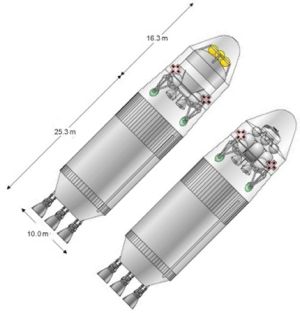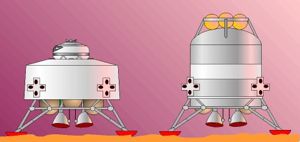
Home - Search - Browse - Alphabetic Index: 0- 1- 2- 3- 4- 5- 6- 7- 8- 9
A- B- C- D- E- F- G- H- I- J- K- L- M- N- O- P- Q- R- S- T- U- V- W- X- Y- Z
Design Reference Mission 1
 DRM 1 Vehicles NASA Design Reference Mission 1 Mars Mission Vehicles Credit: © Mark Wade |
Status: Study 1993.
The plan, unveiled in May 1993, was a NASA version of Zubrin's Mars Direct, using larger spacecraft, but compensating for this by using nuclear thermal instead of chemical propulsion. Six crew would be sent on a conjunction class trajectory to Mars, with propellant for the return trip being obtained by an ISRU propellant plant on the surface.
In the original Mars Direct scenario the Earth Return Vehicle would lift off directly from the Mars surface toward the trajectory toward earth. In the NASA version a Mars Ascent Vehicle would rendezvous with a Mars Orbit way-station, which would provide more space for the crew on the long return.
A 240-metric ton payload heavy lift launch vehicle would be required. In September 2007 three HLV launches would each place an unmanned payload and a nuclear thermal rocket stage into low earth orbit. Payloads on the three launches would be the Cargo Lander, the ERV Orbiter, and the Unmanned Habitat Lander, each with a mass of 60 to 75 metric tons. NASA felt these figures were more realistic than Mars Direct's 30 to 40 metric ton estimates. The Cargo Lander consisted of the Mars Ascent Vehicle, an ISRU facility, hydrogen feed stock, and 40 metric tons of cargo, including a surface rover. The ERV and Habitat Common Module were similar to the Mars Direct 'hockey puck' aerobraked package.
The spacecraft would arrive at Mars in September 2008. The ERV would aerobrake into orbit, while the other elements would aerobrake directly to a landing on the surface. The Cargo Lander would begin manufacture 5.7 metric tons of methane and 20.5 metric tons of liquid oxygen from the atmosphere.
One cycle later, in October-November 2009, another triple launch would occur, this time with a crew of six aboard the Habitat Lander. The duplication of spacecraft provide back-ups for the first set, or if not needed, then spacecraft for the next crew. They would land near the first Cargo Lander and Habitat, both of which were equipped with wheels to allow them to be joined together into a single pressurized base. A 600 day stay would include several 10-day traverses up to 500 km from the lander. In October 2011 the crew would ride the Mars Ascent Vehicle portion of the first Cargo Lander rockets to Mars orbit using propellants generated on the Martian surface. It docks with the Earth Return Vehicle, which the crew then lives in during the coast back to earth. At earth the crew would enter the Mars Ascent Vehicle command capsule, then separate the ERV, re-enter the atmosphere, and land below parachutes on earth.
After this study, the NASA Mars Manned Space Office was again dismantled.
Design Reference Mission 1.0 Mission Summary:
- Summary: NASA's "Design Reference Mission" based upon previous studies; good focus on operations and science return
- Propulsion: Nuclear thermal
- Braking at Mars: aerodynamic
- Mission Type: conjunction
- Split or All-Up: split
- ISRU: ISRU
- Launch Year: 2007
- Crew: 6
- Mars Surface payload-metric tons: 63
- Outbound time-days: 150
- Mars Stay Time-days: 610
- Return Time-days: 120
- Total Mission Time-days: 880
- Total Payload Required in Low Earth Orbit-metric tons: 900
- Total Propellant Required-metric tons: 340
- Propellant Fraction: 0.37
- Mass per crew-metric tons: 150
- Launch Vehicle Payload to LEO-metric tons: 240
- Number of Launches Required to Assemble Payload in Low Earth Orbit: 3
- Launch Vehicle: DRM1
Family: Mars Expeditions. Country: USA. Spacecraft: Cargo Lander Reference Version 1, Crew Lander Reference Version 1. Agency: NASA. Bibliography: 1988, 4429, 591.
 | DRM 1 on Surface Credit: © Mark Wade |
Back to top of page
Home - Search - Browse - Alphabetic Index: 0- 1- 2- 3- 4- 5- 6- 7- 8- 9
A- B- C- D- E- F- G- H- I- J- K- L- M- N- O- P- Q- R- S- T- U- V- W- X- Y- Z
© 1997-2019 Mark Wade - Contact
© / Conditions for Use